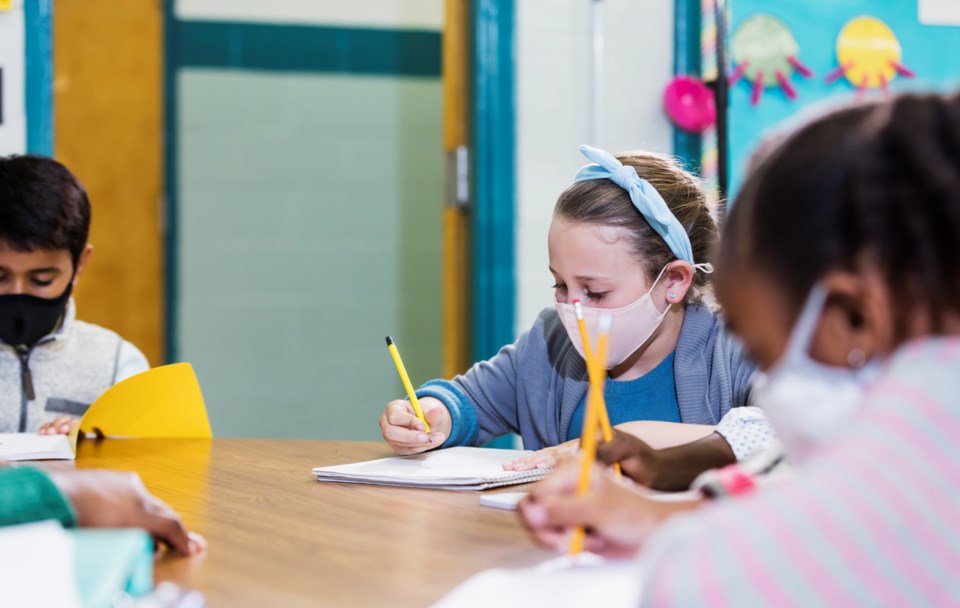Sea to Sky students likely noticed a few changes when they returned to class on Monday, Jan. 10, following an extended holiday break.
At Whistler Secondary School, for example, those changes—triggered by surging Omicron cases—include staggered start times and dismissals, and lunches eaten in classrooms so masks can be worn in spaces like the gym and hallways. Students will also store their boots, jackets, backpacks and textbooks in classrooms for the month of January, rather than in lockers, according to a letter sent to parents.
Across the Sea to Sky School District (SD48), existing safety measures like daily health checks and staying home if sick, hand-washing and mask-wearing will be reinforced; while school gatherings and events will be held virtually whenever possible. In-person events like sports games and theatre productions will not exceed 50 per cent of site capacity and no outside spectators will be allowed, while all extra-curricular sports tournaments involving three or more teams are on hold.
B.C. K-12 schools’ reopening, originally scheduled for Jan. 3, was delayed to give school districts time to implement additional protocols and public health officials time to assess the risks posed by the Omicron variant. Schools remained open to children of frontline workers and those with special needs.
“Our school staff and our district staff spent the week getting ready, and big thanks to them,” said SD48 superintendent Chris Nicholson. “They really worked hard to ensure we opened on [Jan. 10] with our protocols in place, as well as did some planning so if we do have a potential school closure, that we’re ready to pivot to provide support for kids.”
Education Minister Jennifer Whiteside said on Friday, Jan. 7 that individual COVID-19 exposures in schools will no longer be reported to parents, as the more-transmissible variant continues to complicate COVID-19 contact tracing efforts. Instead, attendance will be closely monitored, and reported to public health officials if it falls below typical rates.
A dip in attendance could elicit an investigation by Vancouver Coastal Health, and a resulting “health closure” if the school’s case count is deemed concerning.
Nicholson said SD48 is currently “gathering information” to establish its attendance baselines. On Monday, “if we look at across the district, I think it’s fair to say there was an increased number of kids away than is typical,” he acknowledged. “But not to the extent that ... [it] caused concern in terms of public health considerations.”
The school district has also been bracing for potential staff shortages. SD48 administrators could implement a “functional closure” of a school if a lack of staff compromises its ability to provide the level of instruction, supervision, support, or custodial services needed to ensure students’ health and safety, Nicholson said.
During either type of closure, instruction would temporarily shift to online learning.
A functional closure, however, would be a last resort for SD48, said the superintendent. “We’ve got a number of strategies ready to go,” Nicholson explained, from bringing in teachers on call to rotating educators and administrators into new roles, classrooms and even schools as needed.
“We’ll do what we can, safely, to keep schools open, and it would only be in the event that we feel we fully exhausted everything that we then make a connection with the provincial government to let them know that [temporarily shifting to online learning] is what we’re feeling we need to do,” he said.
In the event of a functional closure, schools would strive to stay open for children of essential workers or students that need extra supports they can’t access at home, Nicholson added.
While other school districts have named a hard-and-fast number of missing students or staff that would warrant a health or functional closure in their schools, Nicholson said the scenario isn’t so black and white for SD48.
Because school sizes vary greatly across the corridor and “because we’re small, we’re able to know our schools really well,” he explained. “I think that gives us a little more flexibility in making decisions.”
In terms of student attendance, “we’re a little different here,” Nicholson added. “We’ve got some amazing kids who are away [because they’re] competitive athletes. We don’t want to inadvertently say, ‘Oh gosh, we’ve reached this threshold,’ and find out it’s because we’ve got a group of kids training for downhill ski racing.”
The province has also committed to distributing rapid tests to B.C. schools in the coming days.
Provincial Health Officer Dr. Bonnie Henry acknowledged last week that concern among parents—especially those with vulnerable family members—is understandable, but schools are safe places to be because of the structure in place.
—With files from Jeff Bell, Times Colonist




